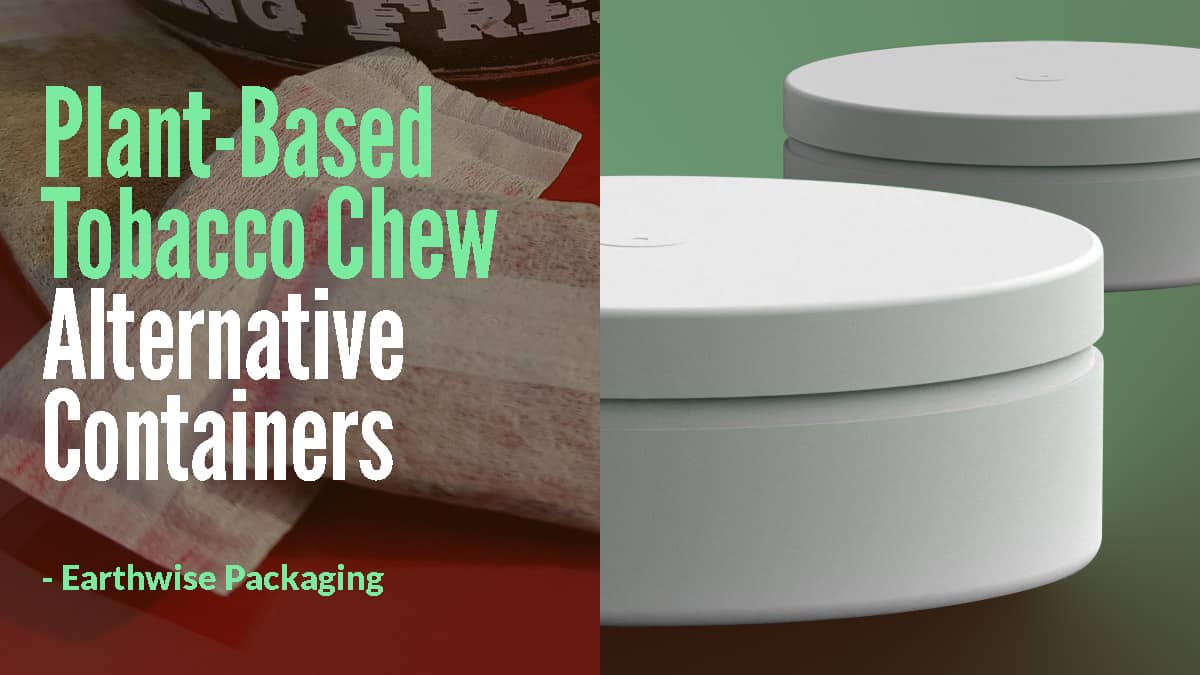Chew Cans
Buy Plant-Based Copenhagen Snuff Containers
Promote Your Snuff with Containers from Plant-Based Cans
When it comes to product branding packaging for smokeless tobacco products, nothing beats Copenhagen snuff. Here, we are going to look at the Copenhagen snuff containers as a case study for branding your own smokeless tobacco product line. We will also talk about how you can update Copenhagen snuff’s marketing strategies to increase your brand’s appeal among eco-minded customers.
Copenhagen Smokeless Tobacco Packaging
Copenhagen snuff was first manufactured in the early 1820s by George Weyman in Pittsburgh, Pennsylvania. Copenhagen snuff quickly grew in popularity. Today, the Copenhagen snuff container is one of the most iconic smokeless tobacco packaging products of all time. This is no accident. Weyman put extra effort into his branding, and Copenhagen snuff became one of the first brand name products in the United States.
After approximately 50 years in the business, George Weyman passed the company down to his sons, who changed the name to Weyman & Bro. Weyman & Bro. focused on branding from the start, developing a logo that incorporated a “W” for Weyman and a “C” for Copenhagen. This logo was stamped on Copenhagen container lids and used in advertisements for a unified branding campaign.
In 1942, Copenhagen snuff temporarily switched from metal lids to fiberboard lids to encourage saving metal for the war effort. This “Fiberwar Lid” was one of the first times Copenhagen snuff used its lids to align its product with the times and appeal to customers. Today, Copenhagen snuff occasionally offers “limited edition” lids, with camo patterned lids being especially popular among collectors. A series of special lids being released in honor of Copenhagen snuff’s 200-year anniversary are sure to become treasured collectors’ items as well.
The Magic of the Round Two-Piece Container
Copenhagen snuff remains one of the top-selling smokeless tobacco products in the world. Some of the strategies mentioned above contributed to this popularity. However, more subtle elements were at play, too.
The first element is the shape of the snuff container (also called a chew can or dip can) itself. These containers, with flush sides and detachable lids, are a superb choice for:
- Packaging for candy
- Packaging for mints
- Arts and crafts containers
- Air freshener containers
- Chewing tobacco packaging products
- Snus packaging products
- …and even tobacco substitute gum packaging
Snuff cans, such as the Copenhagen snuff container, are a compact, rounded shape. They often range in volume from 1 to 2 ounces. Not only does this round shape feel good in a customer’s palm, but the package itself offers valuable “real estate” for branding.
The Copenhagen brand capitalizes on its limited-edition lids because people pay attention to the design of snuff can lids. Keep this in mind as you select packaging for your product line. The rounded lid of a snuff can-style container provides you with uninterrupted space for an eye-catching logo or text. Pressure-sensitive labels or shrink sleeve wraps are great ways to take advantage of this round, flat space.
Snuff containers’ rounded shape makes them easy to shrink sleeve, allowing you to apply a safety seal for tamper protection to consumable products. In addition, the containers’ flush sides and a flat bottom provide even more “real estate” for product details such as ingredients, compliance text, and more.
Upgraded Point-of-Sale Containers
In the past, Copenhagen snuff containers set the standard for smokeless tobacco packaging. These containers remain iconic, of course. However, packaging for today’s retail environment requires updates to Copenhagen snuff’s classic container style.
If you sell any type of tobacco product in the United States, your products are most likely situated near cash registers and customer service desks. Non-tobacco products that lend themselves well to snuff-style packaging, such as gum, mints, candy, and snacks, are also likely to be found near checkout aisles.
Products located in-store “transition areas,” such as checkout aisles, require an eye-catching point of purchase packaging. You can maximize the snuff can’s unique attributes to create a point-of-sale container that stands out from the competition.
Be sure to:
- Make the most of the container’s flat lid with a colorful logo and graphics
- Choose hang tab containers for easy access on display racks
- Select containers made with modern eco-friendly material, such as plant-based plastic
As evidence for climate change grows, smokeless tobacco users from all demographics are starting to demand sustainable packaging for their preferred products. Eco-friendly renewable plant-based plastic is no longer a hypothetical option. Instead, sugarcane-based, FDA-approved, high-density polyethylene is now affordable and accessible for businesses of all sizes.
Sourcing Eco-Friendly Snuff Containers
Earthwise Packaging offers sugarcane plastic snuff containers in multiple sizes, with or without attached hang tabs.
All our sustainable plastic containers are:
- FDA-approved and ASTM certified
- Made with medical and food grade material
- BPA Free
- Reusable and Recyclable
When you choose Earthwise Packaging’s carbon-neutral plant-based plastic for your smokeless tobacco products, you immediately reduce your company’s carbon footprint. After extensive research on various types of plant-based plastic, including sugarcane plastic, we here at Earthwise Packaging have chosen Braskem I’m Green™ Polyethylene for our line of plant-based plastic containers.
Braskem has spent years developing their 97% carbon-neutral sugarcane plastic, which is lighter, thinner, and stronger than conventional plastic. The primary resource in our HDPE plastic is ethanol; the key to Braskem’s success is its unique way of sourcing ethanol.
Old-school conventional plastic uses petroleum, a non-renewable resource, as its source of ethanol. As ethanol is extracted from petroleum, carbon dioxide is released into the atmosphere, contributing to global warming.
I’m Green™ Polyethylene, on the other hand, uses sugarcane, a renewable resource, as its source of ethanol. Unlike petroleum extraction, which adds carbon dioxide to the atmosphere, sugarcane captures carbon dioxide through photosynthesis. And while the amount of petroleum on our planet is limited, renewable sugarcane can be cultivated for years to come.
Plant-based Plastic Containers from California
Want to learn more about sugarcane plastic snuff containers? Then you need to order a sample pack from Earthwise Packaging, your source for factory-direct snuff cans and other plastic containers.
With over thirty years of experience helping small businesses source eco-friendly packaging, we know how to meet your smokeless tobacco packaging needs. All our containers are Made in the USA and ship directly from our facility in Southern California.
Have questions or want to set up an appointment with a representative? Contact us online today.

